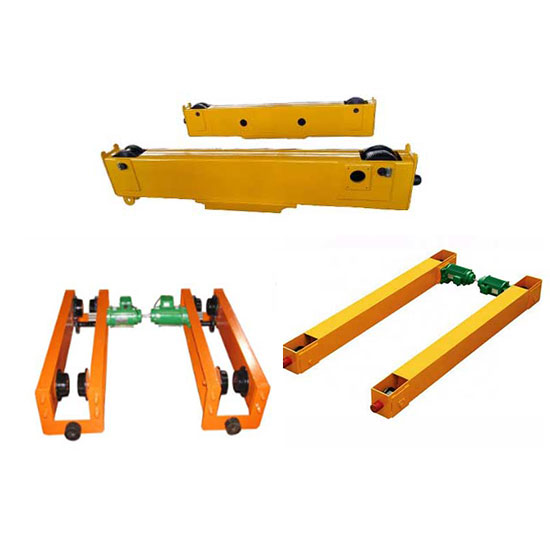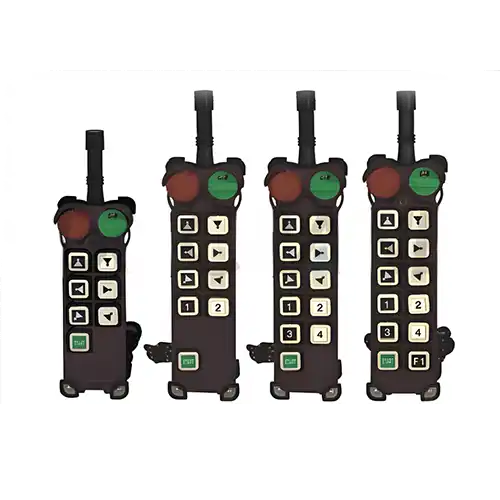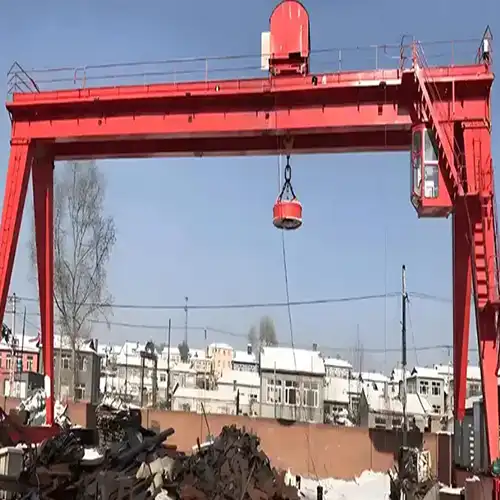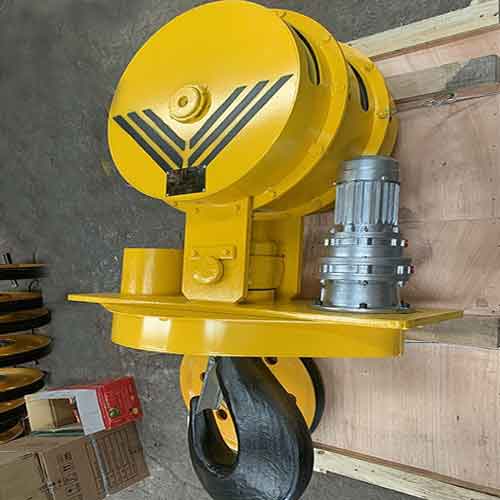Crane end trucks & end carriages
Crane end carriages & crane end trucks for overhead travelling cranes, ie., underhung crane end trucks & top running end trucks, single & double end carriages,etc.
| Crane part | Crane end carriages, crane end truck |
| Types | Single girder & double girder end carriages, Top running & underhung end trucks |
Category: Crane Kit Parts
Your Trusted Overhead Crane Manufacturer & Supplier
Crane End Carriage & Crane End Trucks
Crane end carriages also called crane end trucks are the driving components for overhead travelling cranes moving on rails, which can be connected with crane bridge girder directly.Our crane end carriages have been developed in various designs with high flexibility and high operating reliability to meet your requirements for top running crane end trucks and underhung crane end trucks.
Our crane end carriages and crane end trucks are consisted of a torsionally rigid box structure and complete crane travelling driven units with electric geared motors and crane wheels, rubber buffer, collector bracket base , connection plates and bolts, modular crane components which can be processed to be applied to various crane rails and with all load crane capacity. Our crane end trucks can be designed and fabricated to fit your specific application.

Single beam end carriage up to 20 ton

Double beam end carriage up to 75 ton
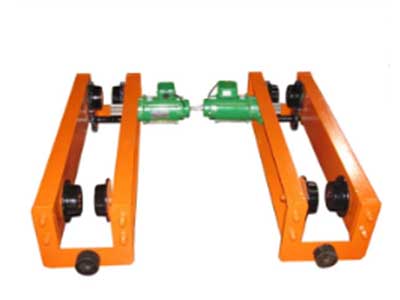
Suspended end carriage up to 10 ton
As a well known and rich-experienced manufacturer and supplier, our crane end carriages are designed and processed with advanced technology and with high standard quality control which can be connected directly to load-bearing superstructures of top running overhead travelling cranes with the specifications and parameters as following:
- Top running single girder crane up to 20 ton,
- Top running double girder crane up to 75 ton
- Span of top running overhead travelling crane:18--35m
- Lifting height of top running overhead travelling crane:10m
- Working Duty of top running overhead travelling crane :M5
- Track length of top running overhead travelling crane:3--30 m/min
We offers a wide range of end carriages for top running single girder overhead travelling cranes with capacities up to 20 tons, crane end carriages for top running double girder overhead travelling crane up to 75 tons, and crane end trucks for underhung suspension crane for capacity up to 10 ton.
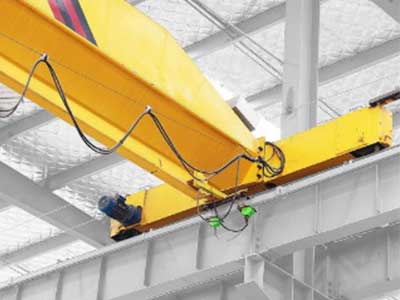
Single girder end carriage up to 16 ton LD

Single beam end carriage up to 20 ton HD
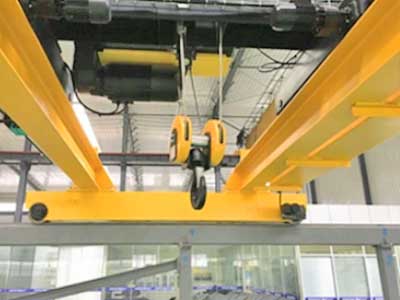
Double beam end carriage up to 75 ton
Overhead Crane End Carriages
Overhead cranes are powerful and indispensable tools in various industries, facilitating the efficient movement of heavy loads within a workspace. At the heart of these impressive systems lie crucial components known as end carriages. In this blog series, we delve into the intricate world of overhead crane end carriages, exploring their definition, components, functionality, design considerations, and more.
To comprehend the role of end carriages, let's begin with their definition. Overhead crane end carriages are structural units located at each end of the crane's bridge girder. These units house essential components that enable the crane to traverse horizontally along the runway beams. Think of them as the wheels and engines that drive the crane's movement, providing the necessary support for the entire system.
The end carriage of a crane refers to the moving part of the crane's trolley, which connects to the main beam. It is the section of the crane beam located at both ends, housing four wheels—two on one side, consisting of one driving wheel and one driven wheel.
The end carriage section is constructed with wheel-assembled beam frames, comprising upper cover plates, belly plates, and lower cover plates. The end carriage is formed by connecting two segments with high-strength bolts, connection plates, and angle steel. Internally reinforced, the end carriage ensures stability when under load. Key dimensions are determined by the main beam span, trolley wheelbase, and crane track gauge. Trolley operation involves separate transmissions. During crane assembly, one end of the end carriage is initially connected to one of the main beams, followed by connecting the two segments.
End Carriage Classification:
The end carriage is categorized into single-beam crane end carriages and double-beam crane end carriages.
End Carriage Models:
- φ200 wheel end carriage specifications: 20012004.5, 20015004.5, 20018004.5, 20020004.5
- φ300 wheel hanging end carriage specifications: 30019004.7, 30024004.7, 30029004.7, 30034004.7 (300 end carriage hanging plate size 30056025)
- 40024004.7, 40029004.7, 40034004.7 (400 end carriage hanging plate size 40060025)
Customization Procedure:
Provide details on the crane's tonnage, span, lifting height, and track model.
End Carriage Configuration:
- A pair (two) of end carriage boxes
- Two motors
- Two reducers
- Four buffers
The end carriage can be equipped with a hanging plate for flexible connection with the main beam, including the installation of bolts.
Importance in Crane System
The significance of end carriages cannot be overstated in the realm of overhead cranes. These components serve as the foundation for the crane's mobility, allowing it to transport heavy loads with precision and efficiency. As the bridge girder moves horizontally, the end carriages bear the weight of the crane and its load, ensuring a smooth and controlled traversal along the runway.
In essence, end carriages play a pivotal role in the overall functionality of the crane system. Their design and performance directly impact the crane's ability to carry out tasks effectively, making them a critical element in various industrial applications.
As we continue our exploration, we'll delve deeper into the components that constitute these end carriages, unraveling the engineering marvel that enables overhead cranes to execute intricate maneuvers with ease. Join us in the next part of this series as we uncover the inner workings of overhead crane end carriages.
The end carriages of overhead cranes are the components located at each end of the bridge girder. They house the wheels on which the crane moves along the runway beams. These end carriages typically consist of a steel frame, wheel assemblies, and a drive mechanism. The wheels are mounted on axles and are designed to travel along the crane runway, allowing the entire crane system to move horizontally.
The drive mechanism, which may include motors and gears, is responsible for propelling the crane along the runway. It enables the crane to traverse the length of the bridge girder and position the load accurately. The end carriages play a crucial role in supporting the crane's movement and ensuring smooth and controlled travel.
In summary, the end carriages of overhead cranes provide the necessary support and mobility for the crane system, allowing it to transport loads horizontally along the runway beams.
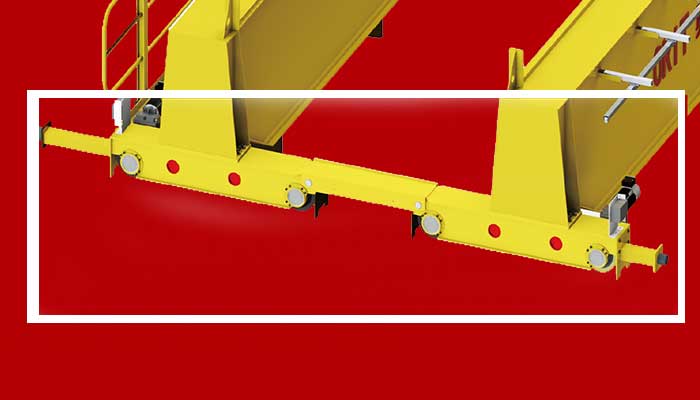
Types of End Carriages for Overhead Cranes
The main types of end carriages in overhead crane systems include:
Top Running End Carriages:
- Run along the top of the crane runway beams.
- Suitable for applications where headroom is not a limitation.
- Commonly used in various industrial settings.
Under Running End Carriages:
- Run along the bottom flange of the crane runway beams.
- Ideal for situations where minimizing overall crane height is crucial.
- Often used in facilities with space constraints.
Single Girder End Carriages:
- Designed to support a single bridge girder.
- Suitable for light to moderate-duty applications.
- Commonly used in smaller capacity overhead cranes.
Double Girder End Carriages:
- Engineered to support two parallel bridge girders.
- Suited for heavier lifting capacities and more demanding applications.
- Provides increased stability and load-bearing capacity.
These main types of end carriages cater to different needs and specifications in overhead crane systems. The choice between top running and under running, as well as single girder and double girder configurations, depends on factors such as load capacity, span, height constraints, and the specific requirements of the industrial application. Each type is designed to meet specific demands and optimize crane performance in various scenarios.
Top Running Overhead Crane End Carriage
The overhead crane end carriages has the features of ultimate light-weight, compact size, and meticulous dedicated design. More picture on overhead end carriage, please check

Modular End Carriage
Spline shaft,direct driving
Light weight,small size
Module joint designing.
Fitting with smallest building clearance
Casting wheels,DIN GGG70
Self-aligning ball bearing using the error caused,can compensate concentricity and deflection
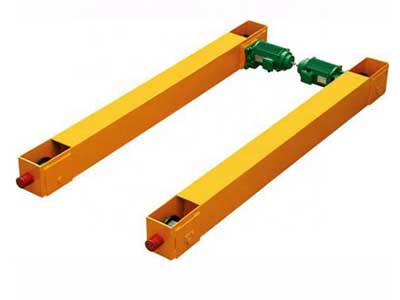
Modular End Carriage
Spline shaft, direct driving
Light weight, small size
Module joint designing,fitting with smallest building clearance
Forging wheels(alloy steel 42CrMo) or casting wheels
Heavy load wheel block, central lubrication
Adjustable vertical inclination and horizontal divergence
Self-aligning ball bearing using the error caused,can compensate concentricity and deflection
Features of Overhead Crane End Carriage
- To meet customer needs, we have enhanced performance while offering more standardized models.
- The track wheel is now made of carbon steel, making it sturdier and longer-lasting.
- Products are primer-coated, which allows customers to choose the desired top coat color.
- Punch-mark on end carriages for easy centering and drilling for girders.

Top Running Single girder Overhead Crane End Carriages
Motorized Overhead End Carriage with Track Wheel Maintenance:
- The maintenance of track wheels is simplified thanks to the open frame construction.
- Smooth travel is ensured through a guide mechanism equipped with side rollers.
Urethane Wheel Motorized Overhead End Carriage for Enhanced Durability:
- Our proprietary urethane wheels contribute to increased durability.
- These wheels run directly over the top flange of the H-beam, minimizing noise and vibration during travel.
- The absence of a light rail reduces installation costs and time.
- Travel remains smooth, facilitated by a guide mechanism featuring side rollers.
Geared Type Manual Overhead End Carriage for Balanced Travel:
- The geared type manual end carriage ensures balanced and smooth travel.
- Pulling the hand chain simultaneously moves both wheels, contributing to a synchronized movement.

Top Running Double Girder Overhead Crane End Carriages
Automated Overhead Double Girder End Carriage with Track Wheel Maintenance:
- The open frame construction makes track wheel maintenance a straightforward process.
- A guide mechanism featuring side rollers ensures a seamless travel experience.
Urethane Wheel Motorized Overhead Double Girder End Carriage for Enhanced Durability:
Our specially developed urethane wheels contribute to increased durability.
- These wheels run directly over the top flange of the H-beam, effectively minimizing noise and vibration during travel.
- The need for a light rail is eliminated, resulting in reduced installation costs and time.
- Travel remains smooth, facilitated by a guide mechanism equipped with side rollers.
Main features of top running end trucks
- Box girder steel structure, rigid and convenient to be connected to the bridge crane girder.
- Rigid end trucks with forged wheel design, long services life, low maintenance rate.
- Quick disconnection electrical plugs and a power lock wheel assembly providing a easy inspection and service.
- Anti-collision rubber bumpers are bolted on crane end trucks to ensure safety with can be removed, replaced and maintained easily.
- Three stage motor-gearboxes, double rim crane wheels, casted or forged steel wheels.
Advantages of top running end trucks
- End carriage of modular design, convenient & flexible assembly
- Light-weighted end trucks with high rigidity
- Crane carriages of wide range of diameter,designed and fabricated to fit your specific application.
- Variable frequency drive, smooth crane travelling
Connections of End Carriages & Main Girders

Standard connection , Center connection, Side connection - Various main girder connection methods, suitable for various factories, reducing factory height.
End Carriages for Overhead Cranes: Top or Side Mounted; for single girder top running overhead travelling cranes.
Our Factory keep in stock a range of crane end carriages, in fact we probably have the largest stocks. The carriages are mainly for single girder top running cranes and our carriages are either side mounted, sometimes called "in shear", or top mounted. both designs have advantages.

End carriages positioned at the top of the crane
In the case of top-mounted crane end carriages, these carriages are situated beneath the main beam of the crane. This configuration offers the advantage of elevating the crane's beam height, potentially reducing the cost of the required column heights to achieve the desired hook height. It also allows the crane's beam to traverse over exceptionally tall machinery. However, a drawback of top-mounted carriages is that the running rails or gantry tracks of the crane will be positioned at a lower level. This can pose challenges, particularly if there is a side door in your factory, and you need to drive beneath the crane tracks from the side.
In situations where space is at a premium, such as a factory with a low roof or a side access door, strategic mounting of crane end carriages on the side or at the end of the crane's main beam becomes crucial. This configuration allows for increased height, facilitating smooth passage for side traffic beneath the gantry rails. We have a track record of successfully installing cranes in tight spaces, with gaps as small as 350mm from the crane rail to the factory roof eaves, all while maintaining the integrity of the Safe Working Load (SWL).
Opting for shear-mounted end carriages proves particularly beneficial for side access scenarios, enabling the elevation of running crane rails to a higher level.
End Carriages of Underhung Bridge Cranes
As a well known and rich-experienced crane manufacturer and supplier, our underslung bridge crane end carriages are designed and processed with advanced crane technology and with high standard quality control which can be connected directly to load-bearing superstructures of under running overhead travelling cranes with the specifications and parameters as following:
- Underhung bridge travelling crane up to 10 ton
- 4 different wheel diameters
- Span of underhung bridge crane up to 28 m
- Lifting height of underhung bridge crane: 10m
- Working duty of underhung bridge crane:M5
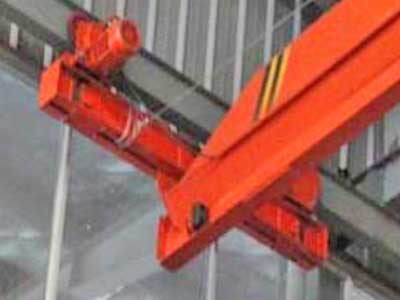
Uderhung crane end trucks for Chinese underhung crane single girder

Uderhung crane end trucks for European style I beam underhung crane

Suspended end carriage for double girder underslung crane
Advantages of Underhung Crane End Trucks
- Crane end trucks are made of rigid steel structure with high geometric precision
- Underhung crane end truck are connected to the main girder with high-strength bolt or by self-locking devices
- Four-wheel pedestal can be designed to fit your crane track perfectly to reduce stress on the crane track;
- Underhung crane end trucks are with optimal designs which can reduce the deflection of running track
- Travel drive with DC disc brakes are equipped on underhung crane end trucks
- Crane wheel drive with lifetime self lubrication to make startup smooth and crane braking with minimal load sway.
Types of Low-Head Underhung Bridge Crane End Carriages:
- Motorized Low-Head End Carriage:- Track wheel and axle designed for easy detachment, reducing installation and maintenance time.
- Urethane Wheel Motorized Low-Head End Carriage:- Utilizes durable urethane wheels developed by KITO and an idling gear in reinforced nylon resin, reducing noise and vibrations during travel. - Track wheel and axle designed for easy detachment, minimizing installation and maintenance time.
- Geared Type Manual Low-Head End Carriage:- Track wheel and axle designed for easy detachment, decreasing installation and maintenance time.
- Plain Type Manual Low-Head End Carriage (No Side Rollers):- Smooth hand pulling operation facilitated by a pressed metal wheel (0.5-ton span 3 m and 1-ton span 6 m) and side rollers (1-ton span 9 m).
- Plain Type Manual Low-Head End Carriage (Side Rollers):- Effortless hand pulling operation facilitated by a pressed metal wheel (0.5-ton span 3 m and 1-ton span 6 m) and side rollers (1-ton span 9 m).
End Carriages with Wheel Heads
The English term "End Carriage" or "End Beam" is used, and the difference lies in the fact that "End Carriage" includes rectangular steel pipes, wheels, motors, etc., while "End Beam" often refers specifically to rectangular steel pipes.
In our current series of end carriage products, they fall under the category of "End Carriage." This series of end carriages primarily adopts a European-style structure, offering single-beam end carriages, double-beam end carriages, and more. Depending on the matching drive motors from different brands, it forms three configurations of integrated gear wheels: Siemens motor-driven, ABM motor-driven, and European-style wheel configuration commonly used with Siemens and ABM motors.

European end carriages with wheel head
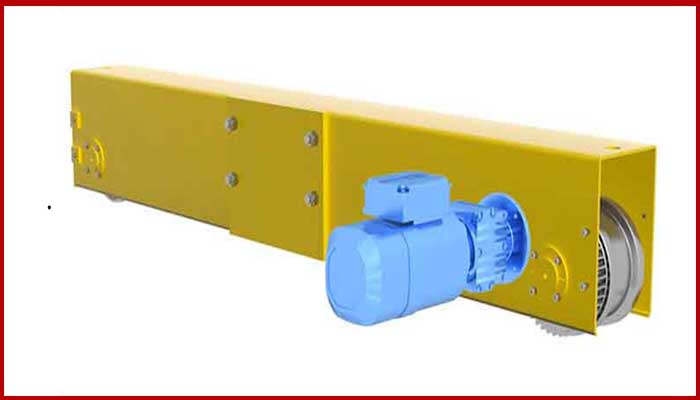
Chinese style end carriage with wheel head
Characteristics of End Carriages with Wheel Heads:
- Supported and suspended end carriages, boogies, and standardized wheel heads designed for bridge cranes, gantries, semi-gantry cranes, single girder/double girder configurations, transfer carts, and various applications.
- Powered by motor-gearboxes exclusively designed for crane and lifting machinery use. Commercial motor-gearboxes can also be installed.
- Extensive variety in diameters, wheel bases, and wheel channels.
- Modular design for End Carriages Module.
- Maintenance-free crane special frequency converting three-in-one; Adjustable wheel set with reduced rail gnawing (patent).
- Wear-resistant and impact-resistant alloy-forged wheel.
- High-precision one-step holistic processing; High strength and flexibility with low alloy material.
Additional Features of End Carriages with Wheel Heads:
- Exposed drive with large ratios and small size.
- Steady and reliable crane special soft start with a three-in-one structure.
- High-precision one-step holistic processing.
- Modular design for flexible assembly.
Why Choose Our End Carriages or End Trucks
- Fully Inverter Ready: Our end carriages are fully prepared for inverter use, ensuring optimal performance.
- Versatile Travel Speed: Achieve a maximum travel speed of 30 meters per minute, with a minimum speed of 5 meters per minute.
- Motor Fan for Cooling: Complimentary motor fan for effective cooling during low-speed travel.
- Stocked Crane Bogies: Ready-to-go crane bogies stocked from 1t to 10t SWL, covering spans up to 18.5 meters. Custom manufacturing available for specific requirements.
- Trusted Supplier: We are a leading supplier to the UK crane trade, serving our own clients and crane designers.
- 12-Month Parts Warranty: Enjoy peace of mind with our 12-month full parts warranty.
We maintain a stock of new inverter-driven end carriages for common crane sizes, offering warranty options of 12 or 24 months. Standard sizes cater to single girder cranes, with top mount and side mount (in shear) connection plates, and long travel drives with fans included.
Advantages of Our End Carriages / End Trucks
Advantages of opting for inverter-driven 50Hz overhead bridge cranes over single or two-speed traveling cranes:
- Load Sway Reduction:- Frequency inverters effectively minimize crane load sway and hook swing.
- Enhanced Safety:- Improved safety during operation, reducing overall wear.
- Smooth and Gentle Movement:- Experience extra-smooth and gentle movement during starting, stopping, and travel.
- Wear and Tear Protection:- Brakes, gearbox, and trolley wheels are shielded against extreme wear and tear, preventing reverse plugging.
- Reduced Maintenance Costs:- Significantly lower maintenance costs as parts almost never wear out.
- Adjustable Long Travel Speed:- The ability to alter the crane's long travel speed within minutes.
- Controlled Acceleration and Deceleration:- Precise control over the acceleration, deceleration, and the time taken to reach top speed and come to a stop.
Components of End Carriages
Exploring Overhead Crane End Carriage Components
In our journey to understand the intricacies of overhead crane end carriages, let's unravel the key components that make up these essential structures. Each element contributes to the overall functionality and efficiency of the crane system.
- Steel Frame-At the core of an end carriage lies a robust steel frame. This structural foundation provides the necessary strength and durability to withstand the heavy loads and dynamic forces encountered during crane operations. The design of the steel frame is crucial for maintaining the integrity of the end carriage, ensuring stability and safety in the crane system.
- Wheel Assemblies-The mobility of the overhead crane is made possible by the wheel assemblies mounted on the end carriages. These assemblies consist of wheels and axles, working in tandem to support the crane's movement along the runway beams.

- Wheels-Wheels are the contact points between the end carriage and the runway. They are carefully designed and constructed to bear substantial loads while maintaining smooth and controlled motion. The material and configuration of the wheels are chosen with precision to optimize performance and minimize wear.
- Axles-Axles serve as the axis of rotation for the wheels, allowing them to pivot and adapt to the contours of the runway beams. The proper alignment and construction of axles are critical for even weight distribution and efficient movement.
Drive Mechanism
Driving the horizontal movement of the crane, the drive mechanism consists of motors and gears. This combination of components is responsible for propelling the crane along the runway, positioning it accurately, and ensuring seamless operation.
- Motors-Motors provide the necessary power to drive the wheels. Depending on the crane's specifications and requirements, different types of motors may be employed, such as electric motors. The motor's capacity influences the crane's ability to handle varying loads and move at different speeds.
- Gears-Gears form the transmission system that translates the rotational power from the motors into the horizontal movement of the crane. The selection and arrangement of gears impact the crane's torque, speed, and precision during operation.
Understanding these components is essential for grasping the mechanical ballet that occurs within overhead crane end carriages. In the next part of our series, we will explore how these components work together to enable the crane's horizontal movement and load positioning.
Comparison of Traditional & European Style End Carriages
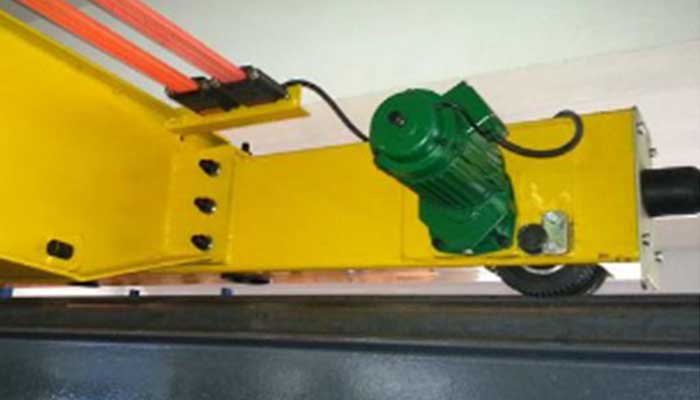
Integrated Gear Wheel End Carriage
Motor-driven with a single-stage open gear transmission between the motor and the wheel. Open gear transmission allows visibility of the gear mechanism, with gears not sealed within a housing. The integrated gear wheel, as shown in the image, belongs to the category of active wheels. The term "integrated gear wheel" is used because of the combined structure of the gear and the wheel.
Applications:
End carriages equipped with integrated gear wheels are commonly used in LDA single-beam, HD single-beam, QDX double-beam configurations, typically operating at working levels of A5 and below. Speed options include 20m/min and 30m/min, with the baseline being 20m/min. For end carriages with a speed of 30m/min, an additional motor cost is incurred. This type of end carriage generally does not equipped with a frequency converter.
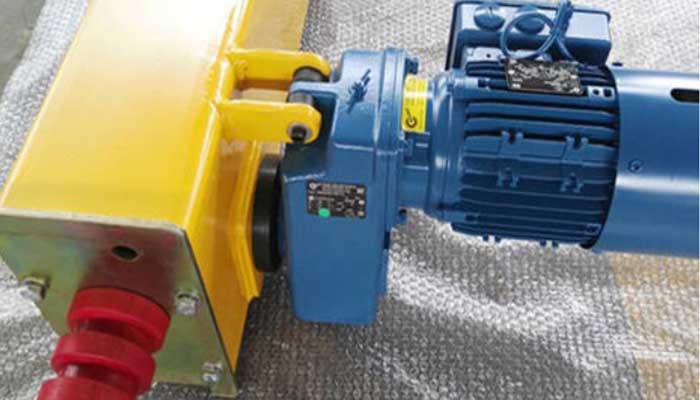
Modular End Carriages
End carriage designed for European-style wheels, where the centerline of the output shaft of the motor drive aligns with the centerline of the wheel axle in a straight line.
Applications:
End carriages configured with European-style wheels are commonly used in HD single-beam, QDX double-beam configurations, typically operating at working levels of A5 and above. Speed options include 20m/min and 30m/min, with the current standard being 30 or 32m/min. Adjustments can be made according to customer requirements.
Unveiling the Functionality of Overhead Crane End Carriages
As we continue our exploration of overhead crane end carriages, it's time to unravel the dynamic functionality that these components bring to the crane system. From horizontal movement to supporting the bridge girder and precise load positioning, each aspect plays a crucial role in the seamless operation of overhead cranes.
Horizontal Movement
One of the primary functions of end carriages is to facilitate the horizontal movement of the entire crane system. The wheels, powered by the drive mechanism, traverse along the runway beams, allowing the crane to reach different areas within the workspace. This horizontal mobility is essential for accessing loads, transporting them across the facility, and positioning them with accuracy.
The drive mechanism, consisting of motors and gears, orchestrates this movement, translating power into controlled motion. The efficiency of this process directly impacts the crane's ability to navigate the workspace smoothly and respond to operational demands.
Support for Bridge Girder
End carriages bear a significant responsibility in providing support for the bridge girder, the horizontal beam that spans the width of the crane system. The steel frame of the end carriage ensures the stability and structural integrity of the entire crane. As the crane moves and lifts loads, the end carriages distribute the weight, preventing sagging or misalignment of the bridge girder.
This support is crucial for maintaining a level and secure platform for the crane's operations. It enhances safety and precision, enabling the crane to handle heavy loads while minimizing the risk of structural issues.
Load Positioning
Precise load positioning is a hallmark of overhead crane systems, and end carriages play a key role in achieving this accuracy. The coordinated movement of the wheels, driven by the motors and guided by the gears, allows for controlled placement of the load. Whether lifting, lowering, or transporting materials horizontally, the end carriages contribute to the crane's ability to position the load with precision.
Load positioning is particularly vital in industries where materials must be precisely placed or assembled. The seamless coordination of the end carriages ensures that the crane can fulfill intricate tasks with efficiency and reliability.
In our journey through the world of overhead crane end carriages, we've uncovered their fundamental functionality. Join us in the upcoming installment as we delve into the design considerations that engineers take into account when crafting these essential components.
Crafting Overhead Crane End Carriages: Design Considerations
In the realm of overhead crane end carriages, the success of their functionality is intricately tied to thoughtful design. Engineers carefully consider various factors to ensure structural integrity, optimize wheel configuration, and enhance drive system efficiency. Join us as we explore the design considerations that shape these critical components.
Structural Integrity
The foundation of any effective end carriage design is structural integrity. The steel frame, serving as the backbone of the end carriage, must be robust enough to withstand the rigors of heavy lifting and constant movement. Engineers meticulously analyze stress points, load distribution, and material strength to craft a frame that ensures stability and durability.
Structural integrity not only safeguards the crane system but also contributes to overall safety in the workplace. A well-designed end carriage minimizes the risk of structural failure, providing a secure platform for the crane's operations.
Wheel Configuration
The configuration of wheels on the end carriage significantly influences the crane's mobility and stability. Engineers carefully choose the type, size, and arrangement of wheels to optimize load distribution and reduce friction. Proper wheel configuration ensures smooth traversal along the runway beams and minimizes wear and tear on both the wheels and the runway itself.
Wheel configuration considerations also extend to factors such as alignment and tracking. Precise alignment of wheels and proper tracking along the runway are crucial for preventing misalignment issues, enhancing the overall performance of the crane system.
Drive System Efficiency
Efficiency in the drive system is paramount for the smooth operation of overhead crane end carriages. The motors and gears that power the wheels must be selected and configured to provide the necessary torque, speed, and control. Engineers aim to design drive systems that maximize energy efficiency while delivering the required performance.
Moreover, advancements in drive system technology, including automation and control features, contribute to enhanced efficiency. Smart control systems enable precise speed and positioning control, improving the crane's responsiveness to operator commands and ensuring the accurate execution of tasks.
Ensuring Longevity: Maintenance and Inspection of Overhead Crane End Carriages
As integral components of overhead crane systems, end carriages require meticulous care to ensure longevity and reliable performance. In this segment, we delve into the critical aspects of maintenance and inspection that contribute to the health of these components.
Regular Inspection Practices
Regular inspections are the cornerstone of preventative maintenance for overhead crane end carriages. Periodic visual inspections, conducted by trained personnel, help identify potential issues before they escalate. These inspections encompass checking for signs of wear, misalignment, and any abnormalities in the steel frame, wheels, and drive mechanism.
In addition to visual inspections, non-destructive testing methods, such as ultrasonic testing or magnetic particle inspection, may be employed to detect hidden flaws or stress points. Routine inspections not only ensure the safety of crane operations but also contribute to the early detection of issues that could impact the end carriage's functionality.
Lubrication Requirements
Proper lubrication is essential for the smooth operation of the wheels, axles, and gears within the end carriage. Lubricants reduce friction, preventing premature wear and ensuring the longevity of moving parts. Engineers specify lubrication intervals based on factors such as load frequency, operational environment, and the type of lubricant used.
Regularly applying the correct lubricants to key components, such as wheel bearings and gears, is a fundamental maintenance practice. Lubrication not only reduces wear but also minimizes the risk of overheating, maintaining optimal operating conditions for the end carriage.
Replacement of Worn Components
Over time, certain components of overhead crane end carriages may experience wear and tear. Prompt replacement of worn components is crucial to prevent operational disruptions and maintain the reliability of the crane system. This may include replacing worn-out wheels, damaged axles, or malfunctioning motors.
Engineers and maintenance personnel should adhere to manufacturer recommendations for component replacement intervals. Scheduled replacements, based on factors like load capacity and usage patterns, contribute to the overall efficiency and safety of the crane.
In our final installment of this series, we will explore the broader applications of overhead cranes and the advancements in end carriage technology that drive innovation in various industries.
Applications & Cases of End Carriages
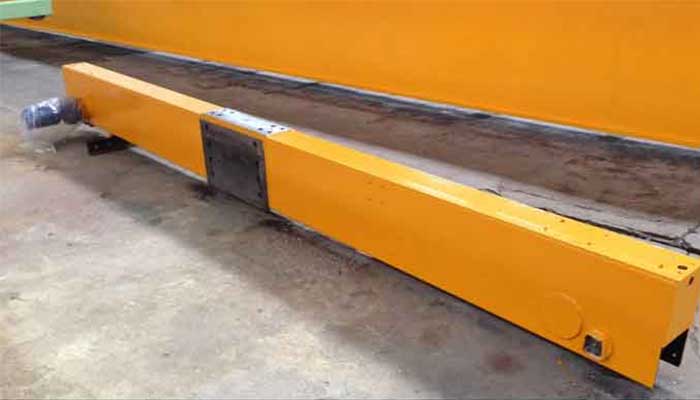
crane end carriages and end trucks

European styel crane end carriages

Double girder crane end carriages
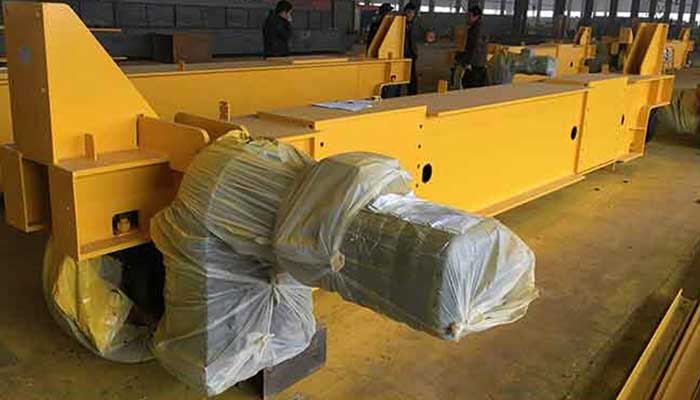
Crane end carriage with crane driving motor
In the grand tapestry of industrial operations, overhead cranes, with their remarkable end carriages, find application in a myriad of industries. Let's explore the diverse sectors that benefit from these lifting giants and the types of loads they adeptly transport.
Industries Using Overhead Cranes
- Manufacturing:Overhead cranes are ubiquitous in manufacturing facilities, where they play a pivotal role in handling raw materials, workpieces, and finished products. Their ability to cover large areas makes them invaluable for tasks such as assembly, machining, and material handling.
- Construction:Construction sites leverage overhead cranes for lifting and placing heavy construction materials. These cranes enhance efficiency and safety in activities like steel erection, concrete pouring, and equipment installation.
- Warehousing and Logistics:In distribution centers and warehouses, overhead cranes streamline the movement of goods, pallets, and containers. They enable efficient storage and retrieval processes, optimizing the logistics chain.
- Automotive:The automotive industry relies on overhead cranes for tasks ranging from moving vehicle components during assembly to transporting heavy molds in foundries. Their precision and lifting capacity make them indispensable in automotive manufacturing.
- Mining:Overhead cranes are employed in mining operations for tasks like lifting and moving heavy equipment, ore, and materials. They contribute to the overall efficiency of mining processes.
- Aerospace:Aerospace facilities use overhead cranes for handling large and intricate components in the manufacturing and assembly of aircraft and spacecraft. Their precision is crucial in the delicate aerospace industry.
- Energy:Whether in power plants or renewable energy installations, overhead cranes assist in the handling of equipment, maintenance tasks, and the installation of components in challenging environments.
Types of Loads Transported
- Raw Materials:Overhead cranes transport raw materials such as steel, aluminum, and other metals within industrial facilities. This aids in the initial stages of manufacturing processes.
- Finished Products:From automobiles to machinery, overhead cranes efficiently move finished products within production facilities, ensuring timely and organized delivery.
- Bulk Materials:In sectors like mining and construction, overhead cranes handle bulk materials such as aggregates, ores, and construction materials.
- Containers and Pallets:Warehouses and distribution centers benefit from overhead cranes for moving containers and pallets, optimizing storage and retrieval operations.
- Heavy Machinery:Overhead cranes are instrumental in the assembly and maintenance of heavy machinery, contributing to the efficiency of manufacturing processes.
- Specialized Components:In industries like aerospace, overhead cranes delicately transport specialized components, ensuring precision in assembly.
As we conclude our journey through the world of overhead crane end carriages, the final part of this series will delve into the technological advancements shaping the future of these indispensable lifting systems.
Advancements in End Carriage Technology
In the rapidly evolving landscape of industrial machinery, overhead crane end carriages stand at the forefront of technological innovation. This final installment explores the cutting-edge advancements that propel these essential components into a new era of efficiency, automation, and enhanced safety.
Automation and Control Systems
- Smart Control Systems:Modern overhead crane end carriages are equipped with advanced control systems that bring a level of intelligence to their operation. These systems enable precise control over the crane's movements, allowing for seamless positioning and handling of loads.
- Remote Operation:Automation extends to remote operation capabilities, where operators can control the crane from a safe distance. Remote monitoring and control not only enhance safety but also contribute to increased operational flexibility.
- Positioning Accuracy:Automation technologies ensure high positioning accuracy, enabling overhead cranes to execute complex maneuvers with unparalleled precision. This is particularly crucial in industries where exact placement of loads is paramount.
- Integration with Industry 4.0:Overhead cranes are becoming integral components of Industry 4.0 initiatives. Integration with digital systems and data analytics allows for real-time monitoring, predictive maintenance, and optimization of crane performance.
Safety Features
- Collision Avoidance Systems:Advanced safety features include collision avoidance systems that use sensors and cameras to detect obstacles in the crane's path. These systems trigger automatic adjustments to prevent collisions, safeguarding both the crane and the surrounding environment.
- Load Monitoring:Real-time load monitoring systems ensure that the crane operates within specified load capacities. This prevents overloading, reducing the risk of accidents and enhancing overall safety in material handling.
- Emergency Stop Mechanisms:Rapid response to emergency situations is ensured through enhanced emergency stop mechanisms. These mechanisms can bring the crane to an immediate halt in critical scenarios, minimizing the potential for accidents.
- Integrated Diagnostics:Technological advancements provide integrated diagnostic tools that enable proactive maintenance. By continuously monitoring the condition of components, these systems can predict potential issues, allowing for timely intervention and reducing downtime.
As overhead crane end carriages embrace these technological leaps, industries worldwide are witnessing a transformation in the efficiency, safety, and adaptability of their material handling processes. The journey from traditional systems to smart, automated solutions marks a new chapter in the evolution of overhead crane technology.
This concludes our exploration of overhead crane end carriages and their multifaceted role in industrial operations. We hope this series has provided valuable insights into the engineering marvels that drive progress in material handling. Thank you for joining us on this journey through the heart of industrial innovation.
Conclusion
As we bring our exploration of overhead crane end carriages to a close, let's take a moment to recap their significance and glimpse into the ongoing developments shaping the future of overhead crane technology.
Overhead crane end carriages serve as the unsung heroes of industrial material handling, providing the mobility and support necessary for the seamless operation of overhead crane systems. From the robust steel frame to the intricate wheel assemblies and the precision of the drive mechanism, each component plays a crucial role in the crane's ability to traverse spaces, support heavy loads, and position materials with accuracy. The structural integrity, thoughtful design considerations, and regular maintenance practices ensure the reliability and longevity of these essential components.
In summary, the significance of end carriages extends beyond their mechanical functions. They embody the reliability and efficiency that industries demand for their material handling processes. As foundational elements of overhead crane systems, end carriages contribute to the overall productivity and safety of diverse sectors, from manufacturing and construction to aerospace and beyond.
Ongoing Developments in Overhead Crane Technology
The world of overhead crane technology continues to evolve, spurred by a relentless pursuit of efficiency, safety, and adaptability. Ongoing developments include:
- Advancements in Automation:The integration of smart control systems and automation technologies is reshaping how overhead cranes operate. This not only enhances precision but also allows for remote monitoring and control, contributing to operational flexibility.
- Safety Innovations:The relentless focus on safety features introduces cutting-edge technologies such as collision avoidance systems, real-time load monitoring, and advanced emergency stop mechanisms. These innovations are paramount in ensuring the well-being of both equipment and personnel.
- Digital Integration and Industry 4.0:Overhead cranes are becoming key players in the era of Industry 4.0, with digital integration enabling real-time data analytics, predictive maintenance, and optimized performance. This digital transformation enhances operational efficiency and lays the foundation for the factories of the future.
As overhead crane technology continues to advance, the synergy between human expertise and technological prowess promises a future where material handling processes are not only efficient but also safer and more intelligent.
We appreciate your company on this journey through the intricate world of overhead crane end carriages. May these marvels of engineering continue to lift industries to new heights, supporting progress and innovation across the globe. Thank you for joining us on this enlightening exploration.
Related Products

Latest project
150 Ton Overhead Crane Installation Feedback – Paraguay Case
QDX 150 ton overhead crane in action in Paraguay. Installation photos, video, and client feedback show performance, safety, and heavy-lifting efficiency.
Free consultation to Confirm Parameters & Specifications and Get
Latest Crane Price & Crane Rate.
- Types of overhead cranes : _______?
- Optional: Overhead travelling crane, goliath gantry crane,Slewing jib crane, Single girder or double girder crane,small portable crane or kbk crane, etc.
- Capacity of overhead crane: _______?
- Optional: 0.25ton, 0.5 ton, 1 ton, 2 ton, 3ton, 5 ton, 10 ton,15ton, 20ton, 25 ton, 30ton,35ton, up to 550ton, etc.
- Crane span & lifting height : _______?
- Crane travelling length : _____?
- Control of overhead crane:_______?
- Optional: pendant/ remote/cabin control
- Voltage supply of overhead crane:_____?
- Eg,: 380V50/60HZ,3Phase or others,etc.
- Application/usage of crane:_______?
- Eg,: Steel mill, ,injection mold, cement,stone, concrete,granite, general manufacturing, etc.
Just leave a message via the contact form and our hoist and crane engineer will contact you with in 24working hours.
Get In Touch
